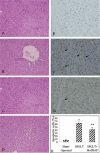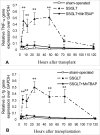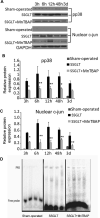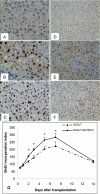SOD mimetic improves the function, growth, and survival of small-size liver grafts after transplantation in rats
- PMID: 22955229
- PMCID: PMC3465521
- DOI: 10.1097/TP.0b013e3182633478
SOD mimetic improves the function, growth, and survival of small-size liver grafts after transplantation in rats
Abstract
Background: Small-for-size syndrome (SFSS) may occur when graft volume is less than 45% of the standard liver volume, and it manifests as retarded growth and failure of the grafts and more mortality. However, its pathogenesis is poorly understood, and few effective interventions have been attempted.
Aims: The present study aimed to delineate the critical role of oxidant stress in SFSS and protective effects of a superoxide dismutase mimetic, Mn(III)tetrakis(4-benzoic acid)porphyrin chloride (MnTBAP), on graft function, growth, and survival in the recipient rats.
Methods: Small size graft liver transplantation (SSGLT) was performed to determine the survival, graft injury, and growth. MnTBAP was administered in SSGLT recipients (SSGLT+MnTBAP).
Results: Serum alanine aminotransferase levels were sustained higher in SSGLT recipients, which were correlated with an increased apoptotic cell count and hepatocellular necrosis in liver sections. Malondialdehyde content, gene expression of tumor necrosis factor α and interleukin 1β, and DNA binding activity of nuclear factor-κB in the grafts were increased significantly in SSGLT recipients compared with sham-operated controls. Both phosphorylated p38 mitogen-activated protein kinase and nuclear c-Jun were increased in SSGLT. All these changes were strikingly reversed by the administration of MnTBAP, with an increase in serum superoxide dismutase activity. Moreover, in situ bromodeoxyuridine incorporation demonstrated that graft regeneration was much more profound in the SSGLT+MnTBAP group than in the SSGLT group. Finally, the survival of recipients with MnTBAP treatments was significantly improved.
Conclusions: Enhanced oxidant stress with activation of the p38/c-Jun/nuclear factor-κB signaling pathway contributes to SFSS-associated graft failure, retarded graft growth, and poor survival. MnTBAP effectively reversed the pathologic changes in SFSS-associated graft failure.
Figures





References
-
- Florman S, Miller CM. Live donor liver transplantation. Liver Transpl. 2006;12(4):499. - PubMed
-
- Fondevila C, Hessheimer AJ, Taura P, et al. Portal hyperperfusion: mechanism of injury and stimulus for regeneration in porcine small-for-size transplantation. Liver Transpl. 2010;16(3):364. - PubMed
-
- Malassagne B, Ferret PJ, Hammoud R, et al. The superoxide dismutase mimetic MnTBAP prevents Fas-induced acute liver failure in the mouse. Gastroenterology. 2001;121(6):1451. - PubMed
-
- Salvemini D, Wang ZQ, Zweier JL, et al. A nonpeptidyl mimic of superoxide dismutase with therapeutic activity in rats. Science. 1999;286(5438):304. - PubMed
-
- Qian JM, Zhang H, Wu XF, et al. Improvement of recipient survival after small size graft liver transplantation in rats with preischemic manipulation or administering antisense against nuclear factor-kappaB. Transplant Int. 2007;20(9):784. - PubMed
Publication types
MeSH terms
Substances
Grants and funding
LinkOut - more resources
Full Text Sources
Medical
Molecular Biology Databases
Miscellaneous

